Growth and Cover Crops
- Bud break finished about 2 weeks ago and we are starting to see some leaves unfold and inflorescence becoming visible. Vineyards vary in phenology from 1 leaf separated through to 4 leaves separated.
- Development is slower than I would like due to the cool wet temperatures (La Nina pattern)
- We are seeing some minor mite damage causing Short Shoot Syndrome (SSS).
- Over winter the mites live in the bud scales and emerge at the same time as the shoots.
- They tend to feed on the growing shoots causing stunted, zig-zagging growth, scaring in the internodes and leaves distortion.
- The shoots will out grow the mite’s ability to keep the shoot stunted but to do that we need nice warm weather.
- Damage is generally sporadic
Figure 1.
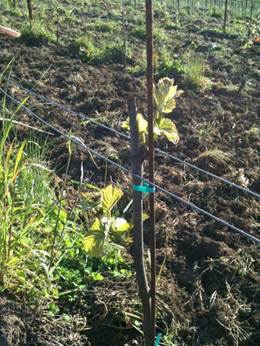
Figure 2. Short shoot syndrome
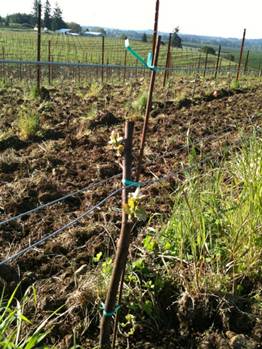
The two vines above were right next to each other in a young Pinot Noir block (4W) at Jacob Hart Vineyard. One showing strong healthy shoot growth and the other suffering from short shoot syndrome. We have treated this block with a light application of sulfur try and knock down the mite population. We will monitor the progress of effected vines and mite populations using double sided sticky tape wrapped around the trunk.
For those that are interested this website offers more information.
http://wine.oregonstate.edu/files/files/Short%20Shoot%20Symptoms%20of%20Grapes.pdf
Cover Crops
Fall cover crops
- We are now starting to work in our fall cover-crops of Winter Rye Grain and Vetch.
- These are planted in the rows that we cultivate to hold the soil in place over winter
- We also get the benefit of nitrogen fixation from the vetch
- Both these cover crops produce a great amount of biomass which is worked into the soil to increase organic matter content, soil life and quality.
- In the less vigorous areas we planted a combination of the two plants to increase soil fertility and possibly vigor (added nitrogen from the vetch)
- In the more vigorous areas we didn’t use vetch because we didn’t want the added nitrogen further increasing vigor.
Figure 3. Winter Rye grain planted in the Pinot Gris block at Jacob Hart.
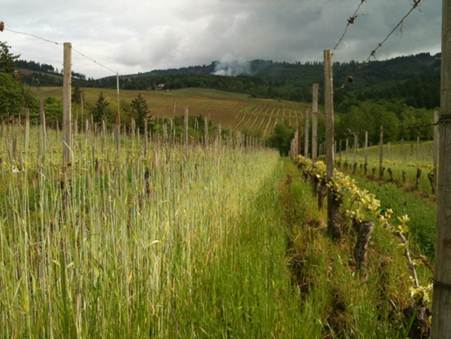
Spring Cover crops
- We have planted buckwheat and wildflowers at many of our sites: Jacob Hart, REX HILL, Pearl, Sims, Foley and Domain Margelle.
- We have planted these for their flowering qualities. These plants will provide nectar for a variety of insects and birds increasing the diversity of life within our vineyards.
- Why buckwheat? Once mature it will flower for a long period of time producing large quantities of nectar. Buckwheat has been shown to increase numbers of predatory beneficial insects and reduce pest populations to below economic thresholds.
Figure 4. Recently germinated buckwheat at REX HILL vineyard.
AVA’s: How many is too many?
He Said...
- Mike Willison
There are currently 199 American Viticultural Areas approved in the US by the TTB, with many more seemingly on the way. 112 of those AVA's are located in winemaking mega-state, California. This is enough until something significant changes. The US has the world's smallest and the world's largest appellations in the Cole Ranch, California AVA at 189 acres and the Upper Mississippi River Valley AVA at 19.1 million acres, respectively. While each state, hamlet and outcropping of rocks aims to distinguish itself by proving to the TTB that it, by virtue of its unique geographic and geological conditions, can make wines of identifiable distinction, three realities exist that preclude anyone from actually caring.
The first is the totally beat-into-the-ground by bloggers and wine geeks that is a totally true trend that most wine is not particularly different seeming than its neighbor geographically, varietally, or by virtue of shelf positioning at the bottle shop.
The second is that the historical precedent for appellations has been eroding into the ether for some time now. 300 years ago the world was very, very big. It was difficult for wine folk from the far reaches of the empire to communicate about methods, best practices and innovation which meant there was little corroboration between the winemakers of Alsace and Sicily, for example. Technique was passed down through generations and was collectively copied and tweaked within villages creating a sense of place that, in today's terms, was extremely small. The world, being very small now, has changed so that community includes us all, from the biggest wine barons to the smallest producer of closet blaufrankish, and we have the same tools, insights and technology available. Our village has become the world.
The third contributing factor is that many wine drinking people just don't care if their wine comes from San Ysidro or the Niagara Escarpment, just that it costs $X, depending on who they are trying to impress, if anyone.
If good wine tastes like it comes from somewhere and bad wine tastes like it comes from anywhere then we have been living in a pretty mediocre time for wine.
She Said...
- Carrie Kalscheuer
While I do think that there is some snobbery and certainly no shortage of marketing involved in the distinction of AVAs, I also think that the regional (and sub-regional) breakdown of winegrowing areas is a practice that can, and should, continue.
Wine regions are created to distinguish one region from the next, some based on soil type, some based on geography, some based on climate. While these may seem arbitrary to the average consumer, they are anything but to the winemakers and grape growers who exist within their confines.
The concept of terroir is alive and well in these debates. And we can't bring up this concept without allowing for its ambiguity. Given this, it doesn't make sense to argue that they are ill-defined or vague. By nature, of course they are.
When we start to ask smaller regions to distinguish themselves from one another without ANY ambiguity allowed, we may find it difficult to distinguish the large ones for truly solid reasons as well. It's a slippery slope. And with so much personal interest locked into the classifications of the different AVAs, attempting to place hard, factual, solid regulations upon a concept that is anything but is an impossible task. I say why try? Drink, enjoy, and be happy that people are taking enough pride in where they make wine to put their region on a map.
Phenological Stages
Viticulturists like to talk about phenology and phenological stages. Phenology is the study of the sequence of plant growth and investigates a plant’s reaction to the environment and attempts to predict its behavior in the new environment. A widely adopted system for recording grapevine phenology is the modified EL system. Below is a snapshot of the EL system.
Most Northern Willamette Valley vineyards are between stages 3 and 4. Lower altitude sites like REX HILL and Jacob Hart Vineyards are mostly stage 4. Historical average budbreak dates for the Willamette Valley are mid April. Why are we around two weeks behind? Because spring has been much cooler than normal due to the La Nina ocean currents in the Pacific Ocean.
Below are historical average monthly temperatures for the Portland area and what has been recorded this year, 2011.
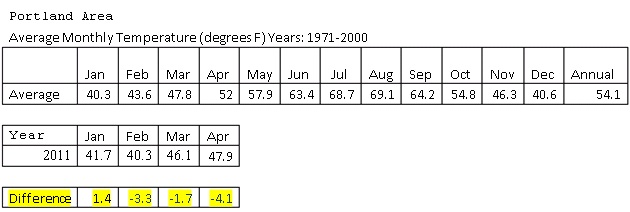
As you can see the months of February, March and April have been colder than average. April’s monthly average temperature was a chilly 4.1 degree F less than average and the predictions moving forward look similar. This is NOAA’s statement for May, June and July.
“THE TEMPERATURE OUTLOOK FOR MJJ 2011 IS, OVERALL, CONSISTENT WITH LA NINA CONDITIONS. PROBABILITIES OF BELOW NORMAL TEMPERATURES ARE ENHANCED FROM THE PACIFIC NORTHWEST EASTWARD ACROSS THE NORTHERN ROCKIES THROUGH THE GREAT LAKES REGION, INTO THE MIDDLE ATLANTIC COAST REGION. THE OCN PREDICTS PROBABILITES FOR ABOVE NORMAL TEMPERATURES ACROSS THE INTERIOR SOUTHWEST.
THE SEASONAL PRECIPITATION OUTLOOK FOR MJJ 2011 CALLS FOR GENERALLY ABOVE-MEDIAN PRECIPITATION IN NORTHERN SECTIONS OF THE CONUS. BELOW MEDIAN PRECIPITATION IS LIKELY ACROSS THE SOUTH-CENTRAL U.S. AND IN PARTICULAR, TEXAS AND LOUISIANA. IN SPITE OF THE EXPECTED WEAKENING OF LA NINA TO NEUTRAL STATUS BY JUNE 2011, THE ABNORMALLY WET SOILS IN NORTHERN SECTIONS OF THE CONTIGUOUS UNITED STATES, AND ABNORMALLY DRY SOILS IN THE SOUTH, ARE LIKELY TO LEAD TO A CONTINUATION OF COOL, WET CONDITIONS IN THE NORTH AND WARM DRY CONDITIONS IN THE SOUTH. “ http://www.cpc.ncep.noaa.gov/products/predictions/90day/seasglossary.html#la%20nina
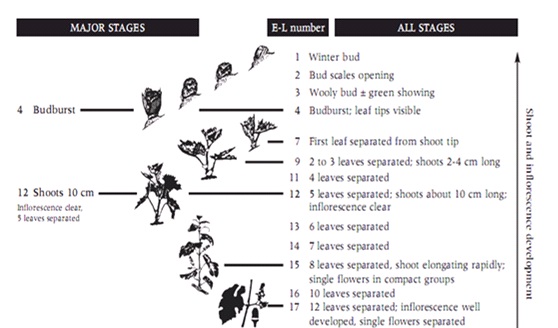
Recent Posts
-
October 12, 2018
-
June 7, 2018
-
October 30, 2017
-
October 23, 2017
-
September 13, 2017
-
April 17, 2017
-
July 21, 2016
-
June 2, 2016
-
May 25, 2016
-
May 18, 2016
Blog Categories
Blog Archives
Our Writers
- Leanne Bellncula (2)
- Shelli Brinson Fowler (1)
- Tom Caruso (2)
- Ryan Collins (20)
- Bill Hatcher (10)
- Deb Hatcher (2)
- REX HILL (59)
- Kelly Irelan (1)
- Carrie Kalscheuer (3)
- Jonathan Lampe (3)
- Karina Lopez (1)
- Meredith McGough (1)
- Katie McLennan (2)
- Charlotte Mischel (2)
- Karen Peterson (2)
- Olivier Prost (2)
- Tom Reed (1)
- Emily Sadler (1)
- Sam Tannahill (2)
- Mike Willison (4)


